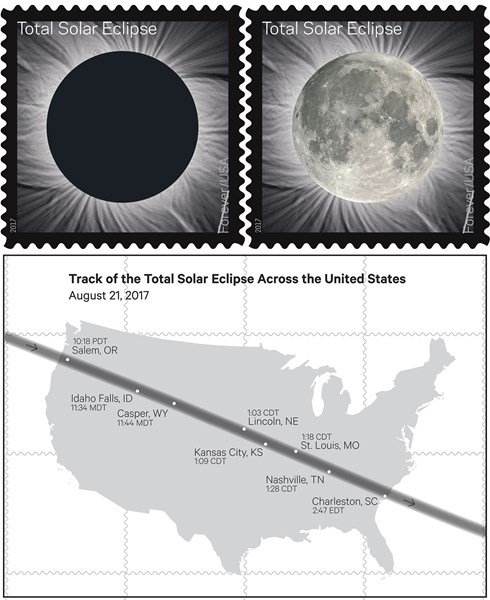WASHINGTON, April 27, 2017 (GLOBE NEWSWIRE) -- The Postal Service will soon release a first-of-its-kind stamp that changes when you touch it. The Total Solar Eclipse Forever stamp, which commemorates the August 21 eclipse, transforms into an image of the Moon from the heat of a finger. The public is asked to share the news on social media using the hashtag #EclipseStamps.
The back of the stamp pane provides a map of the August 21 eclipse path and times it may appear in some locations. Visit NASA's website to view detailed maps of the eclipse's path.
Tens of millions of people in the United States hope to view this rare event, which has not been seen on the U.S. mainland since 1979. The eclipse will travel a narrow path across the entire country for the first time since 1918. The path will run west to east from Oregon to South Carolina and will include portions of 14 states.
The June 20, 1:30 p.m. MT First-Day-of-Issue ceremony will take place at the Art Museum of the University of Wyoming (UW) in Laramie. The University is celebrating the summer solstice on June 20. Prior to the event, visitors are encouraged to arrive at 11:30 a.m. to witness a unique architectural feature where a single beam of sunlight shines on a silver dollar embedded in the floor, which occurs at noon on the summer solstice in the UW Art Museum's Rotunda Gallery.
Thermochromic Ink
The stamp image is a photograph taken by astrophysicist Fred Espenak, aka Mr. Eclipse, of Portal, AZ, that shows a total solar eclipse seen from Jalu, Libya, on March 29, 2006.
In the first U.S. stamp application of thermochromic ink, the Total Solar Eclipse stamps will reveal a second image. Using the body heat of your thumb or fingers and rubbing the eclipse image will reveal an underlying image of the Moon (Espenak also took the photograph of the Full Moon). The image reverts back to the eclipse once it cools.
Thermochromic inks are vulnerable to UV light and should be kept out of direct sunlight as much as possible to preserve this special effect. To help ensure longevity, the Postal Service will be offering a special envelope to hold and protect the stamp pane for a nominal fee.
A total eclipse of the Sun occurs when the Moon completely blocks the visible solar disk from view, casting a shadow on Earth. The 70-mile-wide shadow path of the eclipse, known as the "path of totality," will traverse the country diagonally, appearing first in Oregon (mid-morning local time) and exiting some 2,500 miles east and 90 minutes later off the coast of South Carolina (mid-afternoon local time).
A total solar eclipse provides us with the only chance to see the Sun's corona — its extended outer atmosphere — without specialized instruments. During the total phase of an eclipse the corona appears as a gossamer white halo around the black disk of the Moon, resembling the petals of a flower reaching out into space.
Art director Antonio Alcalá of Alexandria, VA, designed the stamp.
The Total Eclipse of the Sun stamp is being issued as a Forever stamp, which is always equal in value to the current First-Class Mail 1-ounce price.
The Postal Service receives no tax dollars for operating expenses and relies on the sale of postage, products and services to fund its operations.
Please Note: For broadcast quality video and audio, photo stills and other media resources, visit the USPS Newsroom at about.usps.com/news/welcome.htm.
For reporters interested in speaking with a regional Postal Service public relations professional, please go to about.usps.com/news/media-contacts/usps-local-media-contacts.pdf. Follow us on Twitter (twitter.com/usps), Instagram (instagram.com/uspostalservice), Pinterest (pinterest.com/uspsstamps), LinkedIn (linkedin.com/company/usps), subscribe to our channel on YouTube (youtube.com/usps), like us on Facebook (facebook.com/usps) and view our Postal Posts blog (uspsblog.com).
For more information about the Postal Service, visit usps.com and usps.com/postalfacts.
A photo accompanying this release is available at: http://www.globenewswire.com/newsroom/prs/?pkgid=42335
